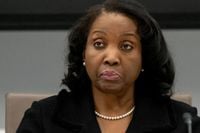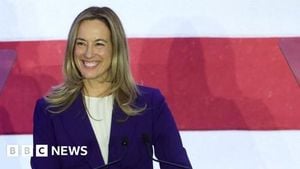In a historic and contentious showdown, President Donald Trump’s push to remove Federal Reserve Governor Lisa Cook has ignited a constitutional and economic crisis that could redefine the relationship between the White House and America’s central bank. This unprecedented clash, unfolding through late August and early September 2025, has left both Wall Street and Main Street on edge, as the dispute threatens the independence that has long underpinned U.S. monetary policy.
On August 29, 2025, an emergency hearing in federal court ended without a ruling on Cook’s urgent request for a temporary restraining order to block her removal. U.S. District Judge Jia Cobb, presiding over the case, indicated that a decision was unlikely before September 4, leaving Cook’s status—and the fate of the Federal Reserve’s autonomy—in limbo, according to Seeking Alpha.
At the center of the storm are unsubstantiated allegations of mortgage fraud leveled against Cook. President Trump’s firing letter, echoing claims made public by housing finance regulator and Trump ally Bill Pulte, accused Cook of making false statements on mortgage documents—specifically, of declaring two different homes in separate states as her primary residence within weeks of each other. Yet, as BBC reports, no formal charges have been filed, and Cook’s lawsuit does not directly address the mortgage accusations.
Cook’s legal team, led by attorney Abbe Lowell, has forcefully argued that Trump’s attempt to oust her is “unlawful and void.” In court, Lowell insisted, “She should not be taken out of her office, she shouldn’t be disconnected from her electronics. She should do all the things that she did a week ago before all this started, because that is the status quo.” The legal battle, they contend, is about much more than a single personnel decision—it’s a fight for the institutional integrity of the Federal Reserve.
Under the Federal Reserve Act, governors can only be removed “for cause,” a safeguard designed to shield monetary policy from the whims of political leaders. Cook was appointed by former President Joe Biden in 2022, becoming the first Black woman to serve on the Fed’s board. Her lawsuit asserts that Trump’s action violates this statute, and that the cited mortgage allegations are little more than a pretext for political retaliation over policy disagreements—especially around interest rates. As The Business Times notes, this is the first time in the Fed’s 111-year history that a president has attempted to fire a sitting governor, placing the country in uncharted legal and constitutional waters.
The White House, for its part, maintains that Trump “exercised his lawful authority to remove” Cook based on credible concerns about her financial disclosures. Justice Department attorney Yaakov Roth argued in court that “cause” for removal should encompass more than just policy differences, stating that a “very senior financial regulatory official” making “contradictory” statements on mortgage documents could constitute reasonable grounds for dismissal.
Yet the broader context is impossible to ignore. Trump’s move follows months of public criticism of Fed officials, particularly over what he perceives as their reluctance to lower interest rates. Cook voted with Fed Chair Jerome Powell to maintain current rates at the committee’s last meeting in July, a stance at odds with Trump’s push for looser monetary policy. Many observers, including former Bridgewater Associates strategist and Council on Foreign Relations fellow Rebecca Patterson, warn that politicizing the Fed could lead to weaker stock performance, higher inflation, and reduced foreign investment. “We shouldn’t ignore this at all,” Patterson told CNBC’s Fast Money. “This is a big deal.”
The market’s reaction has been swift and dramatic. According to Barron’s and Reuters, expectations for a September 2025 rate cut soared from 46.7% prior to Trump’s announcement on August 26 to 87% by September 2. Investors, sensing a weakened and politicized Fed, have flocked to safe-haven assets: gold prices have surged to $3,425 per ounce—a five-week high—while Treasury Inflation-Protected Securities (TIPS) have seen real yields fall to -1.25%. The U.S. Dollar Index (DXY) has dropped nearly 10% year-to-date, further fueling demand for gold and other inflation hedges.
The stakes extend far beyond American shores. As The Business Times and AInvest point out, a politicized Fed could undermine global confidence in the dollar as the world’s reserve currency and create profound uncertainty for international markets. Historical precedents—such as Turkey’s bouts with hyperinflation under President Recep Tayyip Erdogan and Argentina’s repeated fiscal crises—underscore the dangers of eroding central bank independence. If the U.S. were to follow a similar path, capital flight and higher borrowing costs could follow, with ripple effects across Asia, Europe, and emerging markets.
For now, the legal battle rages on. The Federal Reserve itself has remained publicly neutral, stressing that its independence is “critical for maintaining public trust in monetary policy.” Yet the damage to public perception is already evident. A 2025 Pew Research Center survey found that 68% of Americans now believe the Fed is “too influenced by politics,” up sharply from 42% just two years earlier.
Defensive investment strategies are proliferating as uncertainty mounts. Gold and TIPS are in high demand, with gold ETFs and physical bullion allocations up 30% year-to-date. Investors are favoring short-duration bonds to mitigate volatility, and some are diversifying into markets with a reputation for central bank independence, such as Germany and Canada.
The outcome of Cook’s lawsuit could set a precedent that reverberates for decades. If the courts side with Trump, future presidents may feel emboldened to remove Fed officials who do not align with their preferred policies, transforming the central bank into an extension of executive power rather than an independent check. Conversely, a successful defense of Cook’s position would reinforce the principle that monetary policy must remain insulated from partisan agendas.
With the Federal Reserve’s next rate decision scheduled for September 16, all eyes are on Washington. Investors, policymakers, and ordinary citizens alike are waiting to see whether America’s central bank can weather this political tempest—and what the future holds for the world’s most influential monetary institution.





